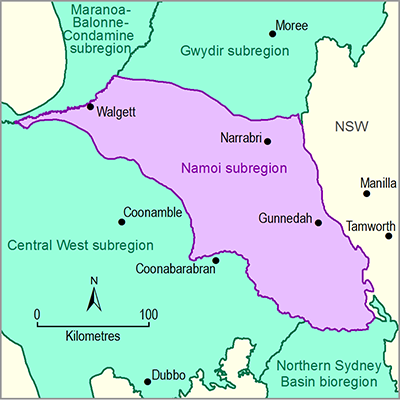- Home
- Assessments
- Bioregional Assessment Program
- Namoi subregion
- 3-4 Impact and risk analysis for the Namoi subregion
- 3.4 Impacts on and risks to landscape classes
- 3.4.2 Landscape classes that are unlikely to be impacted
There are two landscape groups that are automatically ruled out of this component of the analysis. Firstly, the ‘Dryland remnant vegetation’ landscape group is ‘ruled out’ from potential impacts because it comprises vegetation communities that are deemed to be non-water dependent (for further information, see Section 2.3.3 of companion product 2.3 for the Namoi subregion (Herr et al., 2018)). Secondly, the ‘Human-modified’ landscape group (comprising six landscape classes) is excluded from this analysis because it primarily comprises agricultural and urban landscapes that are highly modified by human activity, and contains a set of ecohydological attributes distinct from the other landscape groups (for further information, see Section 2.3.3 of companion product 2.3 for the Namoi subregion (Herr et al., 2018)). Attributes of the water dependency of some aspects of these landscapes are considered elsewhere (see Section 3.5) (i.e. the impact of coal resource development on economic assets such as groundwater bores).
None of the 15 ‘Non-GAB springs’ found in the assessment extent are located within the zone of potential hydrological change. Therefore, this landscape class can be ruled out as it is unlikely to be impacted due to additional coal resource development.
The remaining three landscape groups, and their respective landscape classes that intersect the 7014 km2 zone of potential hydrological change, are considered dependent on groundwater and/or surface water regimes. These landscape groups, therefore, are potentially impacted due to additional coal resource development.

Product Finalisation date
- 3.1 Overview
- 3.2 Methods
- 3.3 Potential hydrological changes
- 3.4 Impacts on and risks to landscape classes
- 3.4.1 Overview
- 3.4.2 Landscape classes that are unlikely to be impacted
- 3.4.3 'Floodplain or lowland riverine' (non-Pilliga) landscape group
- 3.4.4 'Non-floodplain or upland riverine' (non-Pilliga) landscape group
- 3.4.5 Pilliga riverine (upland and lowland)
- 3.4.6 Potentially impacted landscape classes lacking quantitative ecological modelling
- References
- Datasets
- 3.5 Impacts on and risks to water-dependent assets
- 3.6 Commentary for coal resource developments that are not modelled
- 3.7 Conclusion
- Citation
- Acknowledgements
- Contributors to the Technical Programme
- About this technical product
